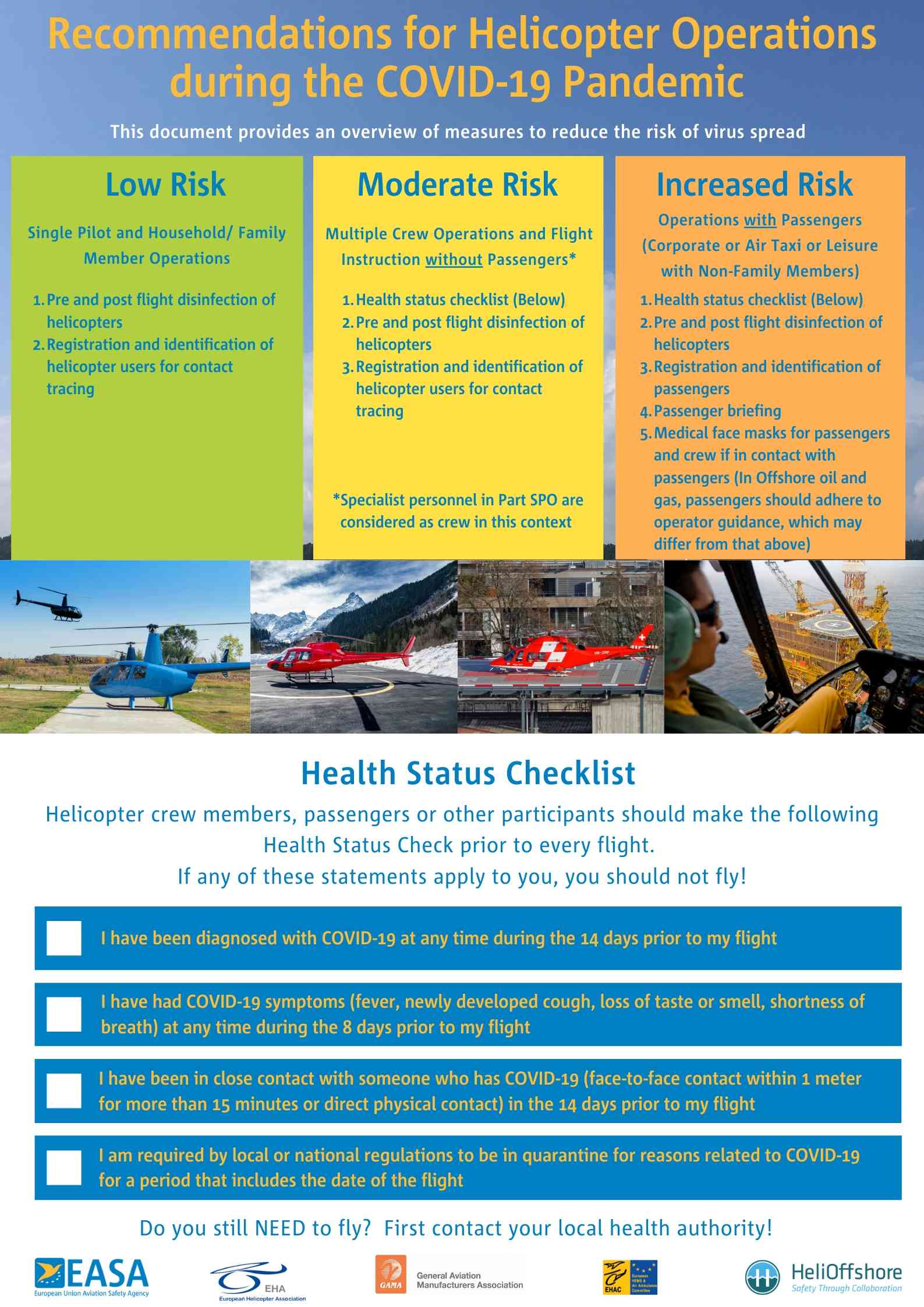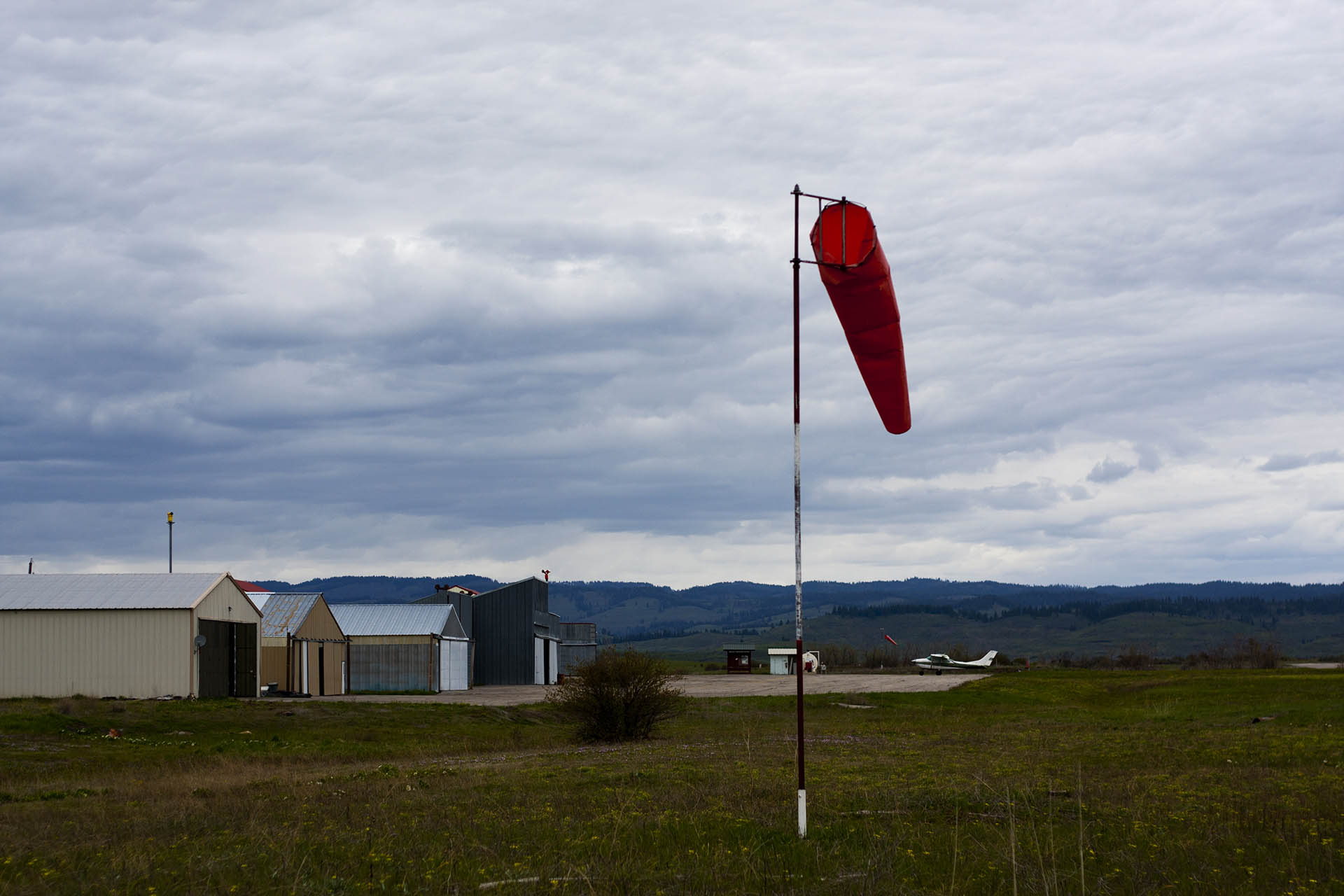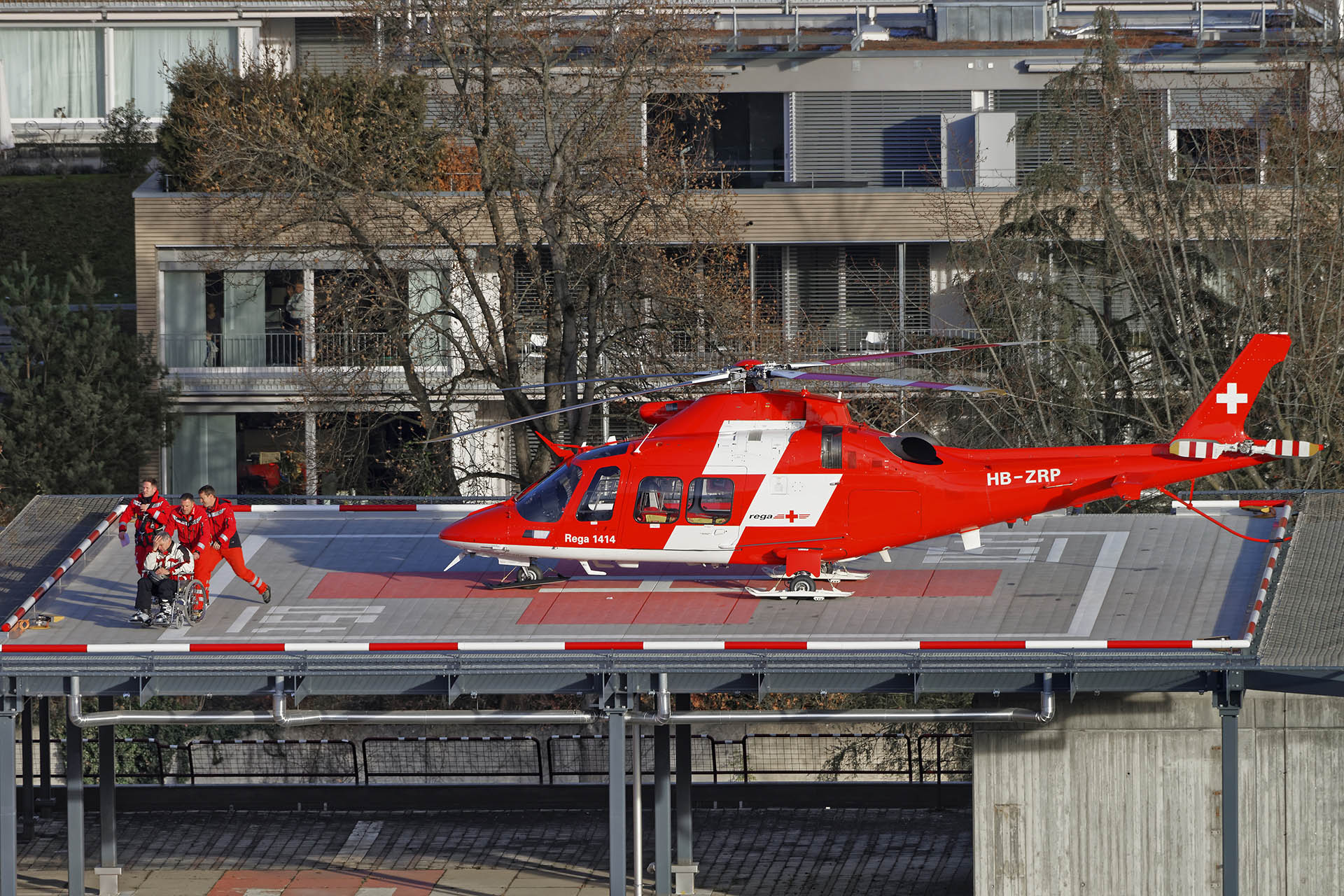COVID-19 is challenging the aviation community like nothing we have ever known. You can find the documents created by EASA and other sources on the Agency’s main COVID-19 page.
Latest Update - 07 July 2020 - Recommendations for helicopter operations during the COVID-19 pandemic
The EASA Rotorcraft Committee has developed the recommendations to help you manage the health risks associated with Helicopter operations during the COVID-19 pandemic - the full information is on a dedicated community site page. The recommendations splits operations into Low, Medium and Increased risk depending on the different type of activity and the people involved. Given the diversity of helicopter operations it is impossible to cover every situation in one graphic. If you have any doubts you can contact your National Aviation Authority or even add any questions to the article here and we will try to assist as quickly as possible.

Official information from EASA
The official EASA information provides operational recommendations for the European stakeholders in accordance with the official communications of WHO and European Centre for Disease Prevention and Control (ECDC) as well as facilitating access to guidance developed by other stakeholders (e.g. IATA, ACI, EU Healthy Gateways, etc.). This page is designed to provide more specific, practical information for the Rotorcraft Community. If there is a COVID-19 related challenge that you are having to solve, hopefully you will find the answers here – if not, let us know.
On 17 April, EASA published guidance on the measures recommended for helicopter operators and Competent Authorities (CAs) regarding helicopter operations. The main focus of this document was to help operators on the frontline to manage the risks during the current COVID-19 outbreak. This guide should be considered by both authorities and helicopter operators in synergy with the recommendations of WHO, ECDC and national public health authorities.
Also of relevance to the helicopter community is the information on the airworthiness aspects for the installation of patient isolation devices and cockpit separations. There is also information on the processing of requests for new configurations for medical transport.
Operational considerations
Emergency measures on small aerodromes and airspace
During the COVID-19 pandemic there are various changes being made to the airspace and opening of small airfields. When planning flights it is important that operators pay attention to:
- The availability of Air Navigation Services (i.e. Air Traffic Control / Flight Information Services, Aeronautical Information Services (incl. NOTAMs), Meteorological Services, Search and Rescue).
- The revised opening hours of small airfields, which might otherwise be used as routine stops for refueling.
Pay particular attention to NOTAMs and Flight Planning

Air ambulance or HEMS flights
From a regulatory perspective, air ambulance flights are considered to be a normal transport task where the risk is no higher than for operations to the full EU OPS Part-CAT and Part-ORO compliance. This is not intended to contradict/complement medical terminology or medical risks but is simply a statement of policy. None of the risk elements of HEMS should exist and therefore none of the additional requirements of HEMS need be applied.
Once the decision between HEMS or air ambulance has been taken by the medical professional, the pilot-in-command/commander makes an operational judgment over the conduct of the flight.
Air ambulance operations could be conducted by any operator holding an Air Operator Certificate, a HEMS approval is not required for all those cases. Especially, in those operations that involve inter-hospital transportation, careful consideration should be given by the medical professional, since several of those flights can be considered ‘normal’ air transport flights, as immediate urgency due to a life threatening situation is not the case.
In those cases the alleviations and exceptional operational conditions, mitigated under the HEMS approval by applying the provisions of Part SPA.HEMS are not necessarily required to be used for those air ambulance flights, hence they can be conducted under the normal CAT provisions. In these situations, the requirements of CAT.POL.H should remain applicable throughout, including the necessity for a Public Interest Site approval, where applicable.
If a medical emergency leads you to need to make use of the alleviations and exceptional operational conditions of Part SPA.HEMS, a HEMS approval is required.
Certification of equipment
Any equipment to be fitted on the helicopter should normally be certified in accordance with the applicable airworthiness requirements. In the current situation, EASA made provisions for CAs to exempt from these equipment requirements in certain cases. Operators should contact their CAs for further details.
Hospital site information
Due to the exceptional circumstances related to the outbreak of COVID-19, there may be an extra demand on inter-hospital transportation. This is mostly because of saturation of the intensive care units of hospitals. In those cases, helicopter operators that are able to conduct these flights could relieve the HEMS operators as long that have the right capability and approved equipment. This would ensure that HEMS services remain available for the most urgent situations.
When a hospital site is located in a congested hostile area, it shall be pre-surveyed by a competent person. Operations manuals should be kept up to date with relevant information. For flight planning and preparation the pilot have easy access to following information:
- All relevant data required to assess compliance with performance class 1 requirements or public interest site requirements.
- A procedure for activating the site with land owner or controlling authority.
In case the hospital site or operating site is not located in a congested hostile area, the relevant information available to the pilot should be as comprehensive as possible. An additional inflight reconnaissance, in accordance with the operator’s procedures, should be considered when needed.
Flights to unsurveyed sites at night is restricted to operators holding a HEMS approval. The use of a night vision imaging system (NVIS) is recommended.

Passenger transport and transportation of task specialists
Operators should consider the specific need for the flight, and undertake those that are needed to support essential activities such as offshore operations, sea-pilot transfer, windfarm operations and specialised operations, such as control flights of pipelines and high tension electricity lines. When you do fly, take the minimum number of essential people needed for the job.
Protection of crew and passengers
To help protect the crew and passengers, you should take a look at the official EASA information in the guidance already provided to operators on ‘Aircraft Cleaning and Disinfection’. Should there be the case of a suspected infected passenger, please refer to these EASA guidelines and apply the guidance as far as practicable for helicopters. It is also important to consider information from your national health authorities. Some key things to think about:
- Respect physical distancing where possible given the confined nature of a helicopter cabin and the number and accessibility of emergency exits.
- The effects of the additional personal protective equipment (e.g. mask, goggles and gloves, especially when worn on during hoisting operations or when wearing survival equipment. Please use common sense.
- The FOD risks of additional requirements, particularly when there is a need for rotors-running refueling/embarkation/disembarkation.
- Cleaning/disinfecting of survival equipment.
- Consider the effect of the air conditioning on the circulation of air (and possible droplets) in the cabin of the helicopter.
- Consider shutting down the rotors, whenever possible, to reduce the dispersal and circulation of any potential COVID 19 droplets.
Transport of COVID infected persons
In giving importance to the health and protection of passengers and crew, and providing the best care for the patient, for these type of operations, helicopter operators should also consider:
- Separation of flight crew from the medical passenger(s) and patient.
- Separation of cockpit and cabin.
- Innovative, or temporary, solutions should only be implemented under an approved design organisation (DOA) and/or in consultation with the airworthiness department of the competent authority, as consideration should be given to whether or not a modification approval13 is necessary.
A specific COVID-19 briefing should take place before each flight, addressing:
- Use of ventilation/air conditioning systems.
- Procedures in the event of malfunctioning of the patient isolation and transportation system.
You should also brief any ground personnel, or hospital staff prior to arrival / departure to reduce the risk of cross contamination during transfer of patients.
For non-HEMS operators, a briefing should be provided to the medical passengers taking into consideration the elements already contained in AMC1 SPA.HEMS.135(a).
Crew considerations
Avoid cross contamination by maintaining the same crews as much as possible. This is not always easy because the technical crew member and medical staff might be employed by a health care provider. Try to liaise with other organisations involved and work together to keep the transmission risks as low as possible.
Crew health and mental fitness to ensure flights can be conducted safely should be the first priority of every operator. Operators and authorities should be very reluctant to touch the Flight Time Limitation (FTL) schemes during this emergency situation. EASA does consider that operators discussing with their authorities any exemption to the FTL schemes, is the very last resort.
Staff wellbeing is also important, EASA Together4Safety worked with the Flight Safety Foundation, Royal Aeronautical Society and Trinity College, Dublin to develop a Wellbeing Guide for Aviation Professionals, please share this with your staff – it is available in English, French and Spanish from the Flight Safety Foundation COVID-19 resources page.
Continuing airworthiness
Work closely with your maintenance organisation to make that the necessary maintenance is carried out to ensure the safety of your operation. taking into consideration the maintenance rules (Part M) and the guidance from the national public Health and Safety authorities.